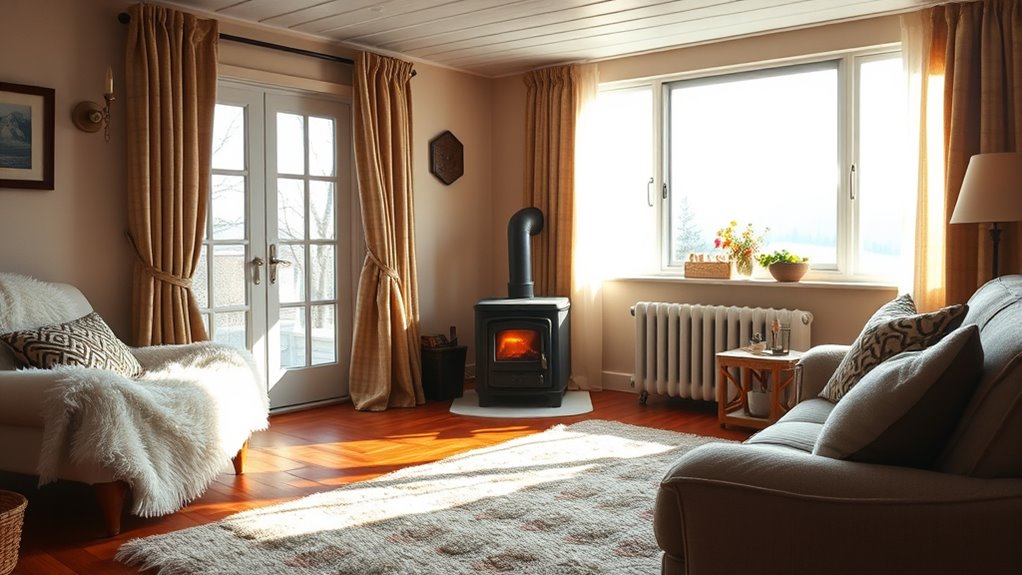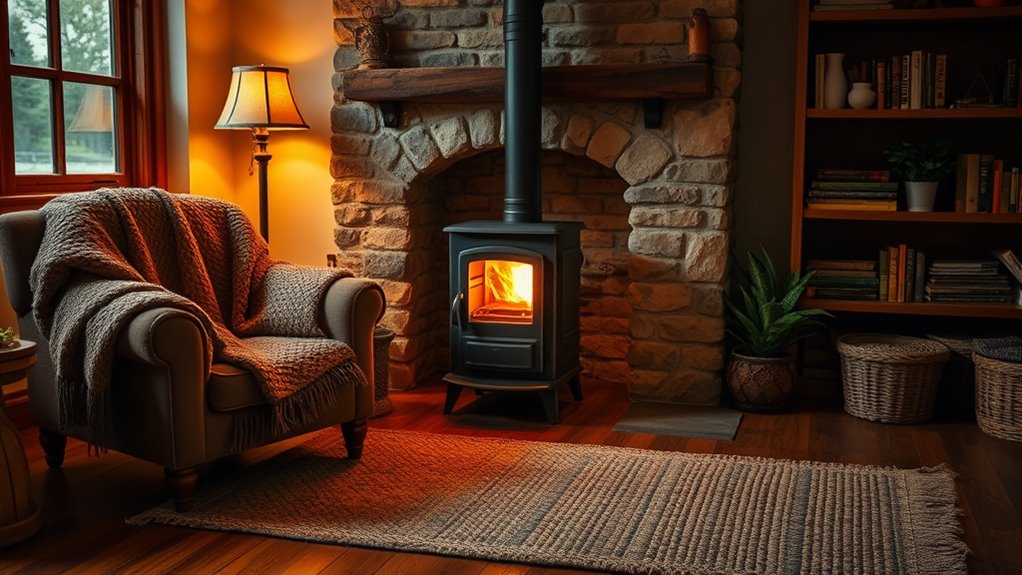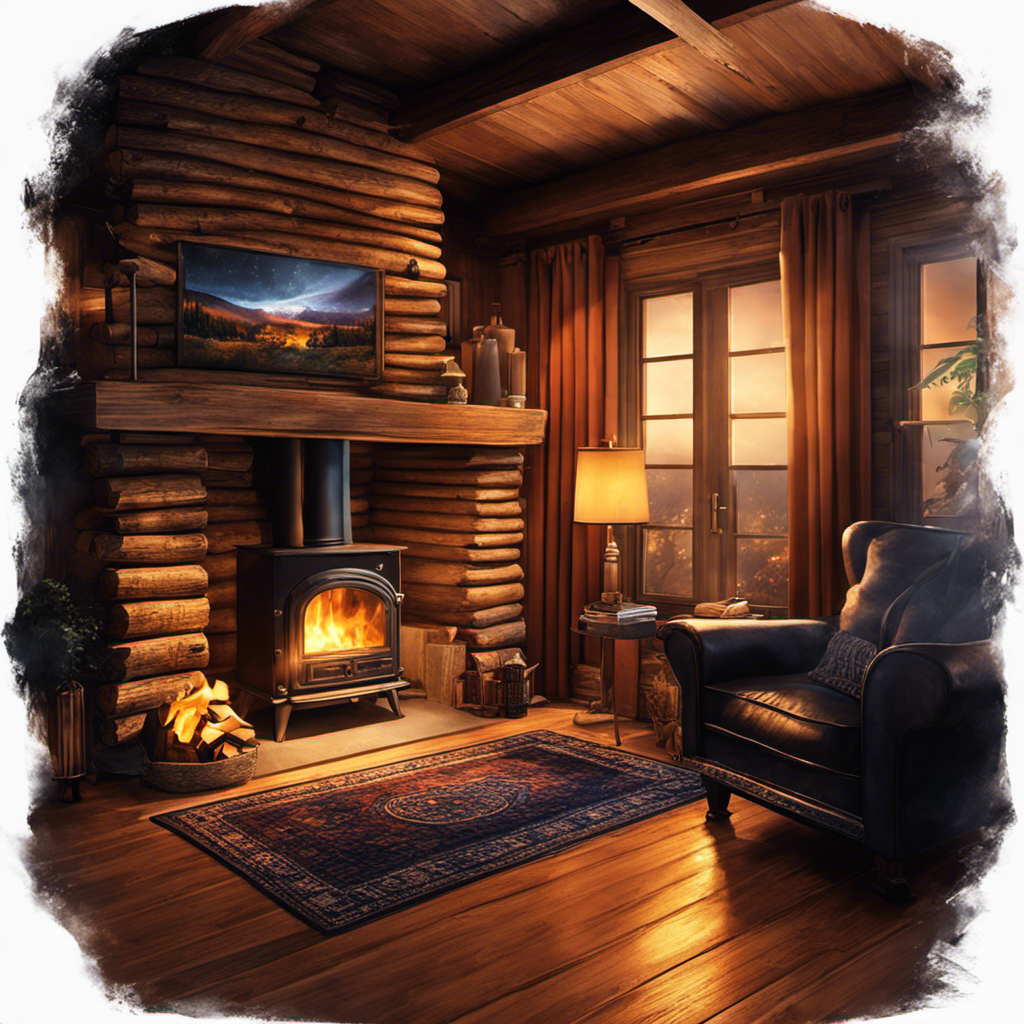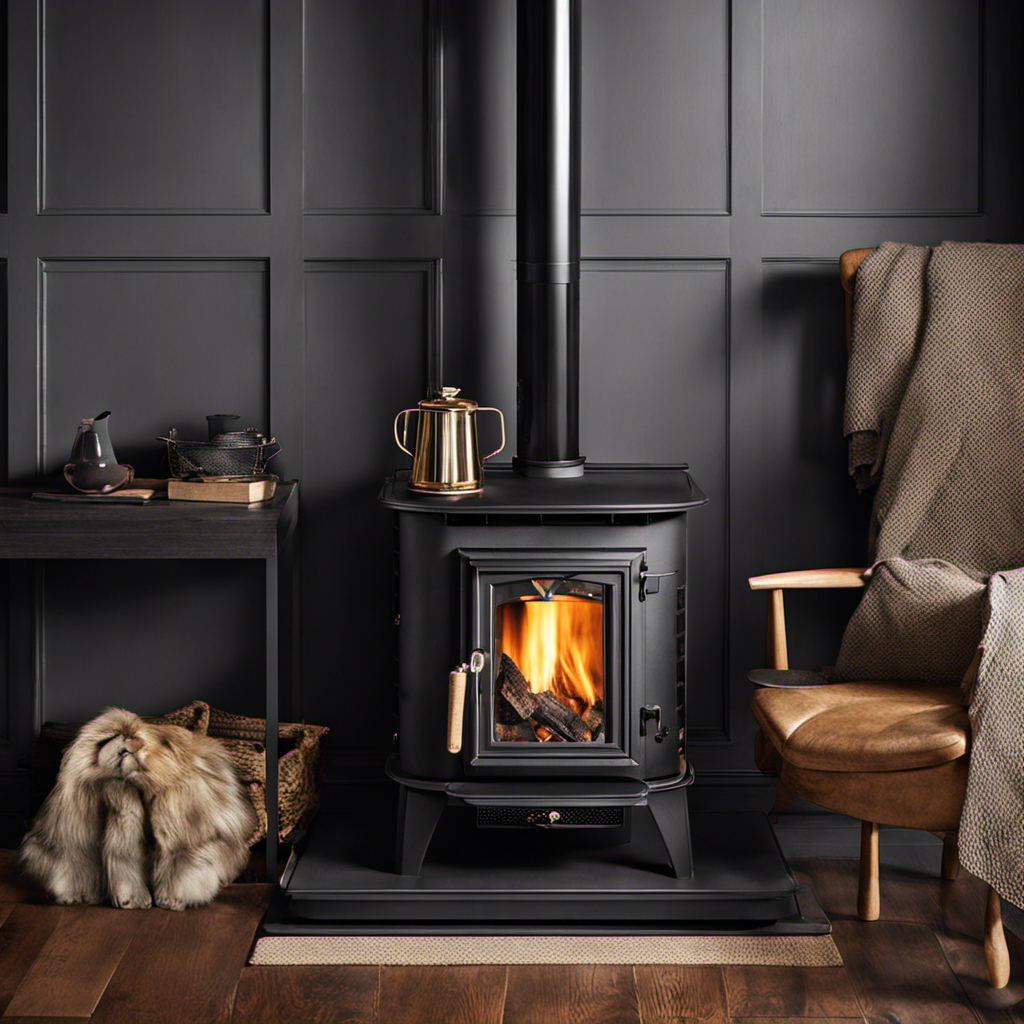To heat your entire home with a small stove, choose one suited to your space, place it centrally, and guarantee proper insulation to retain warmth. Use fans or blowers to distribute heat evenly, and incorporate thermal mass like concrete or brick to help maintain consistent temperatures. sealing drafts and managing air leaks also boost efficiency. If you keep optimizing these strategies, you’ll open up even more tips for cozy, uniform warmth throughout your home.
Key Takeaways
- Select a stove appropriately sized for your home’s square footage to ensure sufficient heat distribution.
- Position the stove centrally and use fans or blowers to circulate warm air evenly throughout all rooms.
- Incorporate insulation, sealing air leaks, and thermal mass to retain heat and improve overall efficiency.
- Use zone heating by focusing the stove’s heat on key areas, minimizing energy waste.
- Maintain safety with regular chimney cleaning, proper ventilation, and functional smoke and CO detectors.
Choosing the Right Small Stove for Whole-Home Heating

When selecting a small stove for whole-home heating, it’s essential to take into account the size of your space and your heating needs. Proper stove sizing ensures you generate enough heat without wasting energy or risking safety. Look for stoves built with fireproof materials like cast iron or steel, which withstand high temperatures and enhance safety. Measure your room or area carefully, and choose a stove that matches its square footage. A stove that’s too small won’t provide sufficient warmth, while one that’s too large could lead to overheating and inefficient use of fuel. Always check manufacturer specifications for recommended space coverage and safety features. Additionally, considering energy-efficient stoves can help reduce fuel consumption and lower heating costs. Staying informed about automation technologies can also help you better understand energy management options for your heating system. Proper installation and venting are crucial for safe operation and optimal performance. Ensuring your stove has fireproof materials and appropriate stove sizing is essential for efficient, safe whole-home heating. Consulting with a professional installer can further ensure your system is set up correctly and safely.
Strategic Placement of Your Stove for Optimal Warmth

Placing your stove in the right spot can substantially improve how evenly your home heats. Position it centrally to maximize heat distribution and avoid placing it near windows or doors that can cause heat loss. Keep your firewood storage close enough for easy access but away from the stove to prevent fire hazards. Guarantee the stove is on a stable, non-combustible surface to enhance stove safety. Clear the area around the stove of furniture or curtains to promote proper airflow and prevent obstructions. Additionally, avoid placing the stove in cramped corners, which can restrict heat circulation. Proper placement not only improves warmth but also ensures safety and efficiency, helping you enjoy consistent comfort throughout your entire home. Ensuring proper ventilation can also improve overall heating effectiveness and air quality. Furthermore, considering tuning your home’s heating system can optimize energy use and maintain more consistent temperatures. Proper insulation can also make a significant difference in retaining heat and reducing energy costs. Using thermal curtains can help trap heat inside during colder months and enhance overall warmth. Adequate airflow management around the stove is essential for optimal heat distribution and safety.
Enhancing Circulation With Fans and Blowers

Using fans and blowers can considerably improve how heat circulates in your home. Proper placement of fans guarantees warm air reaches every corner, while blower fans help distribute heat more evenly. Together, these tools make your small stove’s warmth feel larger and more consistent.
Strategic Fan Placement
Strategic fan placement can considerably improve airflow and heat distribution throughout your home. To maximize airflow optimization, position fans to promote circulation between warm and cooler areas. Place fans near the stove, facing outward, to push warm air into other rooms. Use ceiling fans or oscillating fans to circulate air efficiently. Avoid blocking vents or placing fans in corners where airflow is restricted. Instead, set fans at different heights to encourage vertical circulation. Adjust fan speed based on room size and warmth needs. Remember, proper fan placement ensures warm air moves evenly, reducing cold spots. Incorporating ventilation techniques can further enhance air movement and heat distribution. Utilizing seasonal airflow strategies can help adapt your ventilation to changing conditions and improve overall comfort. Additionally, employing sound design principles can create more pleasant acoustic environments while optimizing airflow. By focusing on effective airflow optimization, you’ll create a more consistent and comfortable home environment with less energy. Properly managing airflow direction also prevents drafts and ensures that heat is evenly dispersed throughout your living spaces. An understanding of air circulation patterns can help you tailor fan placement for maximum efficiency.
Using Blower Fans
Blower fans can substantially boost your home’s circulation by actively moving heated air into hard-to-reach areas. These fans help distribute warmth more evenly, preventing cold spots and ensuring consistent heat circulation throughout your space. Placing blower fans near your small stove directs the warm air outward, improving overall comfort. They are especially useful for pushing heat into distant rooms or upper levels that natural convection might not reach effectively. By increasing air movement, blower fans prevent heat from lingering in one spot and promote a more balanced temperature. Choose adjustable models so you can control airflow based on your needs. Using blower fans is an efficient way to maximize your small stove’s heat output and keep your entire home cozy. Incorporating air circulation principles like optimizing airflow can further enhance your heating efficiency and comfort. Proper ventilation techniques can also help maintain indoor air quality and prevent humidity buildup. Additionally, using fans with variable speed settings allows you to customize airflow for different conditions and energy efficiency. Ensuring good air distribution throughout your home helps maintain a comfortable environment and reduces energy waste.
Insulating Your Home to Maximize Heat Retention

To get the most out of your small stove, you need to keep the heat inside your home. Proper insulation and sealing air leaks make a big difference in retaining warmth. Taking these steps guarantees your home stays cozy without wasting energy. Additionally, understanding the importance of building plans can help you optimize your space for better heat retention. Using self-watering plant pots as an analogy, effective insulation acts like a reservoir that maintains consistent warmth, reducing the need for constant heat input. Incorporating energy-efficient designs can further enhance your home’s ability to retain heat and decrease overall energy consumption.
Maximize Heat With Proper Insulation
Maximizing heat retention starts with proper insulation, which plays a crucial role in keeping warm air inside your home. Well-insulated walls and ceilings prevent heat from escaping, making your small stove more effective. Additionally, consider the placement of fireplace mantels, which can influence heat distribution and comfort. Regular chimney maintenance ensures efficient airflow and prevents heat loss through leaks. To improve insulation:
- Add insulation to attic and walls
- Seal gaps around windows and doors
- Insulate floors and crawl spaces
- Use draft stoppers on fireplace doors and vents
Proper insulation reduces the need for frequent stoking, keeps warmth consistent, and enhances overall comfort. Effective insulation is essential for maximizing heat retention and reducing energy consumption. When combined with good chimney maintenance and strategic placement of fireplace mantels, you’ll enjoy a warmer home with less energy use.
Seal Air Leaks Effectively
Ever wonder how small leaks can drain your home’s warmth? Air leakage allows warm air to escape and cold drafts to seep in, making it harder to keep your home cozy with just a small stove. To maximize heat retention, focus on draft prevention by sealing leaks around windows, doors, and vents. Use weatherstripping or caulk to close gaps and prevent air leakage. Don’t forget to check for drafts near electrical outlets and baseboards, which are common sources of heat loss. Properly sealing these openings keeps warm air inside and cold air out, reducing your heating needs. Paying attention to air leakage and its impact on heat efficiency is crucial for maintaining even warmth throughout your home, helping your small stove do its job more efficiently. Additionally, understanding how insulating your home impacts overall heat retention can lead to more effective energy conservation. Effective insulation minimizes heat transfer, ensuring the warmth stays inside longer and reduces overall heating costs.
Utilizing Thermal Mass to Distribute Heat Effectively

Utilizing thermal mass allows your home to absorb and store heat from your small stove, creating a more even and sustained warmth. By incorporating materials with high thermal mass, you improve heat distribution throughout your space, reducing hot spots and cold areas. This strategy guarantees that heat lingers longer, decreasing fuel needs and maintaining comfort. To maximize this effect, consider:
- Placing heavy materials like concrete, brick, or stone near your stove
- Using thermal mass in interior walls or floors for even heat spread
- Ensuring proper insulation around thermal mass to prevent heat loss
- Avoiding insulation barriers that block heat transfer from the thermal mass
These steps help your small stove work more efficiently by leveraging thermal mass, delivering consistent warmth across your entire home.
Creating a Zone Heating System With a Small Stove

Creating a zone heating system with a small stove allows you to target heat precisely where it’s needed, improving comfort and efficiency. To do this effectively, consider your ventilation needs to guarantee safe air circulation and proper air quality. You’ll want to position the stove in a central location or near the room you want to heat most, while keeping the stove size considerations in mind. A smaller stove can be ideal for focused heating, but ensure it’s large enough to generate sufficient warmth without overloading the space. Proper ventilation is essential to prevent indoor air quality issues, so install vents or exhaust systems as needed. This approach helps you maximize comfort with minimal energy use, making your small stove a powerful tool for zone heating.
Managing Drafts and Sealing Leaks for Better Efficiency

Once you’ve set up your zone heating system with a small stove, the next step is to improve its efficiency by managing drafts and sealing leaks. Draft management involves identifying areas where cold air enters and plugging them up. Leak sealing focuses on closing gaps around windows, doors, and vents to prevent heat loss. Proper leak sealing keeps warm air inside and reduces the workload on your stove. You can use weatherstripping on doors and windows or caulk small cracks. Additionally, draft stoppers on doors and draft snakes at the base of windows make a noticeable difference. Regularly inspecting for leaks and addressing them swiftly ensures your small stove heats your home more evenly and efficiently, saving you energy and money.
Incorporating Complementary Heating Methods

While a small stove can effectively heat a home, combining it with other heating methods can boost comfort and efficiency. Fireplace integration allows you to use your existing fireplace as a supplemental heat source, distributing warmth evenly. Solar heating is an eco-friendly option that captures sunlight during the day to diminish reliance on your stove. To visualize, here’s some ideas:
| Heating Method | Benefits |
|---|---|
| Fireplace Integration | Adds consistent, cozy heat with minimal effort |
| Solar Heating | Reduces energy costs and environmental impact |
Using both methods ensures you’re not over-relying on your small stove and helps maintain a warm, balanced home environment.
Maintaining Your Stove for Consistent Performance

Regular maintenance is essential to guarantee your stove performs reliably and efficiently. Proper upkeep helps prevent safety hazards and keeps your home warm. Start with chimney maintenance by inspecting and cleaning the chimney regularly to prevent creosote buildup, which can cause fires. Keep your stove’s interior clean by removing ash and debris after each use. Check seals and gaskets for wear to confirm suitable heat retention. Also, test smoke and carbon monoxide detectors frequently to maintain stove safety. To maximize performance, follow these steps:
Regular stove maintenance ensures safety, efficiency, and consistent warmth in your home.
- Schedule annual chimney inspections
- Clean the stove’s interior regularly
- Replace worn seals and gaskets promptly
- Test detectors monthly
Consistently maintaining your stove ensures safe, efficient heating and consistent warmth throughout your home.
Tips for Safe and Efficient Small Stove Operation

To operate your small stove safely and efficiently, you need to understand proper handling techniques and safety precautions. Start by choosing the right fuel types—wood, pellets, or gas—based on your stove’s design and your home’s needs. Always use the recommended fuel to ensure ideal performance and reduce safety risks. Keep your stove clear of clutter and combustible materials to prevent fires. Regularly inspect for leaks or damage, and never leave the stove unattended while burning. Maintain proper ventilation to avoid dangerous buildup of fumes. Follow manufacturer instructions carefully, and install carbon monoxide detectors for added safety. Properly managing fuel and adhering to stove safety guidelines helps you maximize efficiency while keeping your home safe and warm.
Frequently Asked Questions
How Can I Prevent Heat Loss Through Windows and Doors?
To prevent heat loss through your windows and doors, you should focus on draft sealing and curtain insulation. Seal any gaps around frames with weatherstripping or caulk to stop drafts. Use heavy or thermal curtains to insulate your windows at night and during cold days. These simple steps trap warm air inside, making your home more comfortable and reducing energy bills. Keep cold air out and warmth in effectively.
What Are the Best Types of Fuel for Small Home Stoves?
When choosing fuel for your small home stove, prioritize fuel efficiency and safety. Wood is a popular option because it’s renewable and provides good heat output, but make sure it’s properly seasoned to maximize efficiency. Pellets are also efficient and burn cleaner, reducing emissions. Avoid using unapproved fuels like gasoline or kerosene, as they pose safety risks. Always follow manufacturer guidelines to guarantee safe, efficient, and consistent heating.
How Often Should I Service or Inspect My Small Stove?
You should follow a regular maintenance schedule and keep up with inspection frequency to guarantee safe, efficient operation. Inspect your stove at least once a month for signs of wear, buildup, or damage. Schedule professional servicing annually to clean the chimney, check for leaks, and verify proper functioning. Regular inspections and maintenance help prevent hazards, prolong your stove’s lifespan, and keep your home warm and safe throughout the season.
Can a Small Stove Effectively Heat Multiple Floors?
You can heat multiple floors with a small stove if you follow proper insulation tips and strategic stove placement. Place the stove centrally to maximize heat distribution, and guarantee good insulation to prevent heat loss. Using fans can help circulate warm air effectively. Keep doors open between rooms to allow heat flow, and consider additional insulation in colder areas to maintain consistent warmth across multiple floors.
What Safety Precautions Are Essential When Operating a Small Stove?
Oh, the thrill of managing a tiny stove—safety first, right? You’ll want to keep a fire extinguisher close by, ideally placed where you can grab it quickly. Don’t forget stove clearance distances; maintaining proper space prevents fires. Always stay attentive, never leave it unattended while burning, and make sure vents and chimneys are clear. Safety isn’t glamorous, but it’s the best way to enjoy cozy warmth without risking your home.
Conclusion
With a little planning and care, your small stove can become a cozy centerpiece that whispers warmth throughout your home. By choosing the right stove, placing it thoughtfully, and maintaining a snug environment, you’ll enjoy inviting comfort even on chilly days. Remember, a gentle touch on safety and efficiency guarantees your space remains a haven of gentle heat and peace. Embrace these tips, and let your home’s quiet warmth softly embrace you.











